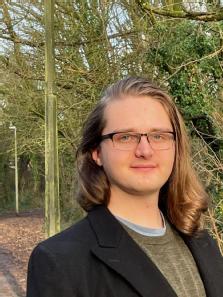Matthew Monk
I am a first-year PhD student (started Oct. 2021) with the Monash-Warwick Alliance working on rare b-decays with the CERN LHCb experiment. I am primarily based at the University of Warwick and supervised by Dr. Matt Kenzie (Warwick) and Prof. Ulrik Egede (Monash).
My project is on the decays of . These decays are interesting for a number of reasons:
- A common final state for the Bs and B0 modes (final state is invariant under U-spin symmetry)
- Final state is the same whether the B-meson is a particle or anti-particle (CP eigenstate)
- Both decays are gluonic penguins i.e. are loop diagrams at the lowest order and are decays of a pseudoscalar (B) to two vector (V) particles (K*0 and K*0 bar)
During my project, there are three main analysis planned:
- Measure the branching fractions and longitudinal polarisation fractions as a ratio between the Bs and B0 modes via the
observableLink opens in a new window
- An analysis with Run 1Link opens in a new window (2011-2012) LHCb data found about a 3σ tension with the Standard Model (SM) prediction
- This will be a time-integrated, flavour-untagged analysis with both the Run 1 and Run 2 (2015-2018) LHCb datasets which will improve the statistically uncertainty and a simultaneous, fit with a direct measurement of
should improve the statistically uncertainty to verify the tension with the SM prediction.
- Measure the Triple Product Asymmetries (TPAs) to search for direct CP violation
- There are three independent momenta, so form a triple-product of them e.g.
- This will also be a time-integrated, flavour-untagged analysis
- Direct CP violation has not yet been observed in B-meson decays to two vector mesons
- The SM model expectation of this TPA is small and so this is a good place to look for new physics (NP)
- As direct CP violation has been seen in other B-meson decays, it would be odd not to observe it in
decays
- There are three independent momenta, so form a triple-product of them e.g.
- Measure the weak phase
- This probes CP violation in the interference between decay and mixing
- It requires a time-dependent, flavour-tagged analysis
has been measured through a range of different decays, and is found to agree with the SM prediction
- The SM prediction is small but non-zero, all measurements have been found to be consistent with the SM expectation and 0 so ideally the experimental uncertainties need to be reduced enough to distinguish between them
- The shared final state between the Bs and B0 modes allows us to make a cleaner interpretation of the measured angle
- The Bs mode was used to measure the angle in Run 1 LHCb dataLink opens in a new window, this analysis will use Run 1 and Run 2 LHCb data and simultaneously measure it using the Bs and B0 mode
Service Work
As a member of LHCb, I also have some work relating to the performance of the detector. During my PhD, my service work will be on the Vertex Locator (VELO). The VELO is a sub-detector of LHCb and is the closest part to the interaction point (where the protons actually collide) and is used to determine where the B-hadrons decay, as B-hadrons have a flight distance on the order of mm in LHCb.
My service work so far has been on improving the model of the new VELO used in simulations. We require a large amount of simulated collision data and the geometry of the detector must be well-modelled to ensure our simulations are accurate.
As part of the LHCb upgrade for Run 3 (which has officially started Summer 2022), a new VELO detector has been installed and so my work has been on finalising the description of it used for Run 3 simulations.
Other activities
I am currently the EPP postgraduate staff-student liaison committee (PGSSLC) representative.
Within LHCb, I am the Run1-2 performance liaison for the BnoC working group.
I am very lucky to have many travelling oppurtunities throughout the lifetime of my PhD, these include:
- 1 month spent at the University of Santiago de Compostela in Spain for June 2022. This was to work more closely with LHCb colleagues who we are collaborating on the K*K* analysis with
- 2 weeks STFC Summer School hosted at Oxford University Sep. 2022
- Approx. 1 year LTA at CERN in the second year of my PhD
- Approx. 6 month LTA at Monash University (as part of the joint-PhD programme) roughly in the 3rd year of the PhD (possibly earlier)



Above: Example Feynman diagrams for the decays
PS0.11, University of Warwick, Coventry, CV4 7AL, UK
